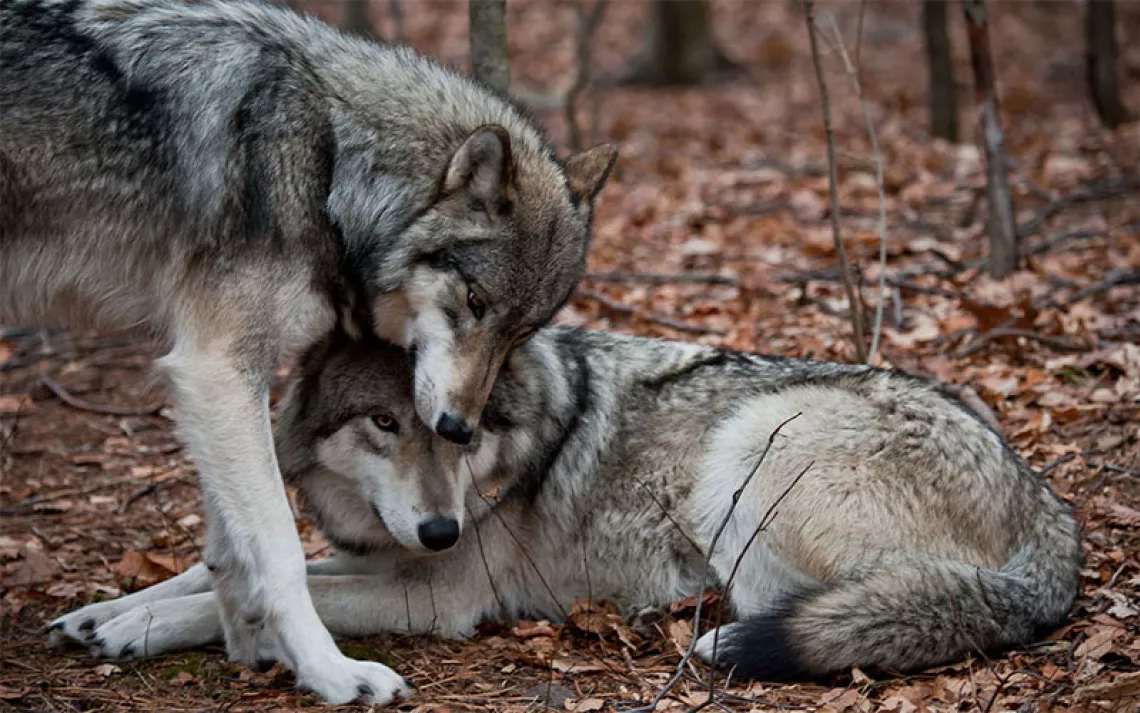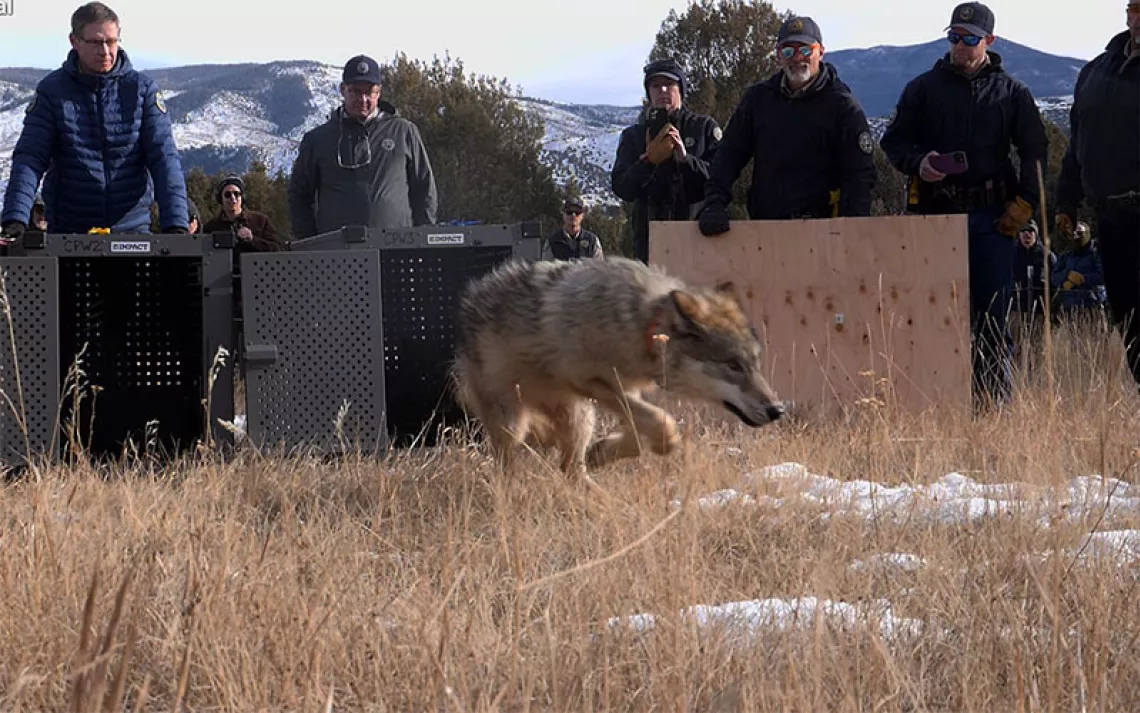Without Federal Protection, Yellowstone’s Wolves Are Being Decimated
Outrage is mounting as hunters kill wolves near the park

Photo by the National Park Service via AP
Rick McIntyre spent last May doing what he has done nearly every morning for the past 26 years: observing wolves in Yellowstone National Park. It was a special time. One of the Junction Butte pack’s breeding females, 907, had recently given birth, and her eight pups had emerged from the den. Often, up to 300 people joined McIntyre on the campground road where he set up his spotting scope so they could watch the pups nursing, wrestling, and tumbling about with the yearlings.
“Seeing the wolf family at their den was likely the best wildlife-viewing opportunity in the world at the time,” recalls McIntyre, who has written several books based on his careful observations of Yellowstone’s wolves.
In early September, Montana’s wolf-hunting season opened. The Junction Butte pups, now old enough to join other pack members on forays, wandered across the park’s northern border. Within a week, hunters killed two pups and a yearling, all females.
As of this writing, hunters have killed at least 20 individuals that are considered “Yellowstone wolves,” including six members of the Junction Butte pack. The Phantom Lake pack has lost so many members that park officials declared it “eliminated.” While some of the wolves were killed in Wyoming and Idaho, the majority have been killed by Montana hunters, some of whom used bison carcasses as bait—perfectly legal under new state regulations.
On December 16, park superintendent Cameron Sholly sent Montana governor Greg Gianforte a letter. Citing the unprecedented number of Yellowstone wolves killed, he urged the governor to suspend hunting and reinstate quotas in the two management units bordering the park. Sholly pointed out that the hunting is likely to take a toll on area businesses that rely directly or indirectly on wildlife watching. Seemingly unmoved, Gianforte forwarded the letter to his state’s Fish and Wildlife Commission. But as the killing continues, a chorus of outrage is swelling, and wolf advocates are working to reinstate protections for the park’s iconic predators.
Park rangers eliminated the last wolves in Yellowstone National Park in the 1920s. Wolves were reintroduced in 1995, and the project has been lauded as a conservation success story. Wolves have attracted droves of visitors to the park, and their presence has boosted biodiversity.
“We’ve had this makeover in Yellowstone,” says Doug Smith, a senior wildlife biologist at Yellowstone, in a Q&A video hosted on the park’s website. “Prior to wolf recovery, we had a lot of elk and coyotes but very little willow and aspen and songbirds and beavers.”
Though ecologists argue the finer points and stress that the interactions are complex, there is broad consensus that the return of wolves has helped create a healthier Yellowstone. Wolves also help suppress ungulate diseases such as chronic wasting disease by selecting sick individuals, says Norman Bishop, a retired Park Service naturalist interpreter who played a key role in wolf reintroduction.
“One of the elements of a healthy planet is the health that predation produces in wild ecosystems,” Bishop says.
Yellowstone National Park occupies the northwest corner of Wyoming and is bordered by Montana to the north and Idaho to the west. Though hunting of wolves is prohibited within the park, it has occurred outside its borders since 2009, when wolves in Montana and Idaho were first removed from protection under the Endangered Species Act. (Those wolves were relisted after a legal challenge, but the entire Northern Rockies population, excepting Wyoming, was delisted in 2011. In 2017, wolves in Wyoming were delisted too.)
Up until last year, Yellowstone wolves that wandered out of the park were partially protected by strict quotas in the two management units adjacent to the park’s northern border. Only one wolf could be “harvested” in each of these units. The number of Yellowstone wolves killed by hunters averaged under 3 percent of the park’s total wolf population.
“People fought really hard for that quota,” says Bonnie Rice, senior representative for the Sierra Club's Greater Yellowstone/Northern Rockies campaign. “We don’t want to see any trophy hunting of wolves, but at least [the quota] recognized the importance of Yellowstone wolves, the research that’s happening in the park, and the role wolves play in the regional economy. All of that has gone out the window.”
Last August, Montana’s Fish and Wildlife Commission approved regulations that allow up to 82 wolves to be harvested in Region 3, which includes the two management units. That change, plus liberal hunting and trapping guidelines, have taken a devastating toll. The 20 wolves killed this season represent nearly 20 percent of the Yellowstone population—and the season isn’t even over.
Some wolf advocates, including a coalition of area business owners, are following Sholly’s lead and calling on the state of Montana to reinstate the one-wolf hunting quotas in the two management units immediately to the north. Others are appealing to the federal government to reinstate protections for the wolf.
On January 13, a group of 30 guides, photographers, and other business owners who operate in and around Yellowstone sent a letter to Interior Secretary Deb Haaland, urging her to return wolves to the endangered species list. In it, they argue that management practices in Montana, Idaho, and Wyoming “are jeopardizing the biological integrity of the Greater Yellowstone wolf population” and have the potential “to swiftly reverse decades of recovery.” They note that a healthy wolf population “is critical to the success of our businesses, our jobs, and the strength of the region's large tourism and recreation economy.”
In a press release announcing the letter, Cara McGary, owner of In Our Nature Guiding Services, states, “The economic value of wolves seen alive is orders of magnitude greater than those killed.”
Since wolves were reintroduced to Yellowstone, park visitation has soared. Over 4.4 million people visited Yellowstone in 2021, and as polls consistently reveal, wildlife watching is one of the top reasons people come. The business coalition estimates the annual economic impact of wolf recovery to be $80 million, when adjusted for inflation. Much of that money is spent on restaurants, lodging, and other businesses in the surrounding communities.
Trophy-hunting pressure will likely alter the wolves’ behavior, making them warier of humans and hence less “watchable.” In fact, McGary says wolf sightings in the northern range are already becoming scarcer. Hunting may also compromise one of the parks’ goals, which is to maintain a wolf population in as natural a condition as possible.
“We know the individual makeup of packs affects how they compete with each other,” says Smith in the video Q&A. “It also affects how they prey on elk.” Large male wolves are important for taking down large elk, and, according to Bishop, breeding females make key decisions such as where to den. The loss of these important individuals can impact whether pups survive and if the pack stays together.
Pressure on Secretary Haaland is mounting. The Global Indigenous Council, conservation groups, and separate groups of senators and representatives have all sent letters calling for an emergency relisting.
Aside from the ecological and financial impacts, the loss of some of Yellowstone’s most-watched wolves is a gut punch for long-time guides, wolf aficionados, and biologists.
McIntyre wants people to consider what it would be like to take their kids to Yellowstone to watch the Junction Butte pack pups, only to learn later that several of the family had been killed. “What is it worth to you to have a national park in our country where you and your family can come and watch a wolf pack with pups?” he asked.
 The Magazine of The Sierra Club
The Magazine of The Sierra Club



